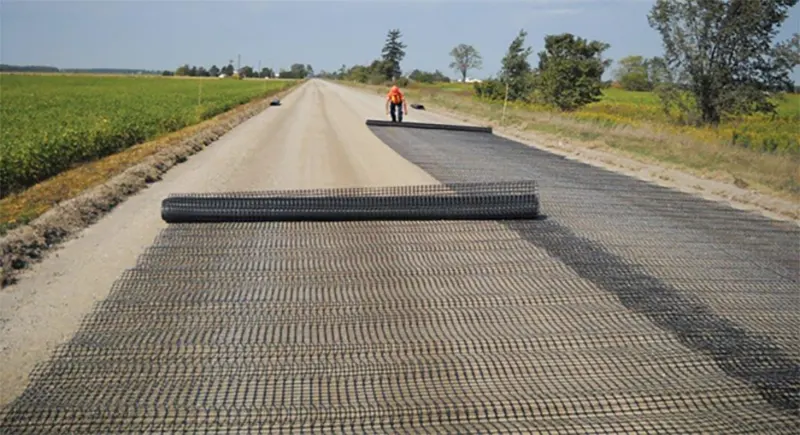Geotextiles are permeable fabrics that, when used in association with soil, have the ability to separate, filter, reinforce, protect, or drain. Typically made from polypropylene or polyester, geotextiles come in three basic forms: woven, non-woven, and knitted. Each geotextile types and uses has distinct characteristics and is suitable for specific applications in civil engineering, construction, and environmental projects.
Woven Geotextiles
Definition and Construction: About woven geotextile are manufactured by interlacing two or more sets of yarns at right angles. The weaving process produces a strong, durable fabric with high tensile strength and a relatively low elongation rate, making it suitable for applications requiring load-bearing capacity.
Properties:
- High Tensile Strength: The interlacing process provides woven geotextiles with superior tensile strength compared to non-woven varieties, making them ideal for reinforcement applications.
- Low Elongation: These fabrics exhibit minimal stretch, which helps maintain soil stability and structure.
- Permeability: Although less permeable than non-woven geotextiles, woven varieties still allow for some water flow, providing adequate drainage in certain applications.
- Durability: Woven geotextiles are resistant to UV degradation, biological attack, and chemical exposure, ensuring a long service life even in harsh environmental conditions.
Types of Geotextiles
1. Woven Geotextiles: As previously discussed, woven geotextiles are characterized by their high tensile strength and durability. They are particularly effective in applications requiring soil stabilization and reinforcement, such as road construction, embankments, and retaining walls.
2. Non-Woven Geotextiles:
- Manufacturing: Non-woven geotextiles are produced by bonding fibers together through chemical, mechanical, or thermal means, rather than weaving.
- Properties: These geotextiles are typically more permeable and have higher elongation rates, which makes them suitable for filtration and drainage applications.
- Applications: Non-woven geotextiles are used in drainage systems, erosion control, and as protective layers in landfills.
3. Knitted Geotextiles:
- Manufacturing: Knitted geotextiles are made by interlocking loops of yarn, which can be produced through warp knitting or weft knitting.
- Properties: They offer flexibility and can conform to irregular surfaces, making them useful in unique applications.
- Applications: Knitted geotextiles are less common but can be used in specialized situations where flexibility and adaptability are required.
Uses of Geotextiles
1. Soil Stabilization and Reinforcement:
- Road Construction: Woven geotextiles are often used to reinforce roads by distributing loads and preventing the mixing of subgrade and aggregate layers, thus enhancing road longevity and performance.
- Retaining Walls and Embankments: These structures benefit from the high tensile strength of woven geotextiles, which provide necessary support and stability to resist soil movement and prevent erosion.
2. Filtration and Drainage:
- Drainage Systems: Non-woven geotextiles are widely used in drainage applications due to their permeability, which allows water to pass through while retaining soil particles.
- Erosion Control: Geotextiles can be used to protect soil surfaces from erosion by wind or water, helping to maintain landscape integrity.
3. Separation:
- Railway and Roadway Construction: Geotextiles prevent the intermixing of different soil layers, maintaining the integrity of the construction materials and improving the load-bearing capacity of the ground.
- Landfills: In landfill construction, geotextiles are used to separate waste materials from underlying soils, preventing contamination and aiding in the effective management of landfill sites.
4. Protection:
- Geomembrane Protection: Geotextiles can act as a protective layer over geomembranes, preventing punctures and damage from sharp objects, thus enhancing the longevity and effectiveness of the barrier systems.
5. Environmental Applications:
- Reed Bed Construction: In wastewater treatment systems, geotextiles support the growth of reed beds by providing a stable medium and facilitating water flow.
- Coastal and Waterway Protection: Geotextiles are employed in the construction of breakwaters, revetments, and other coastal structures to protect against erosion and stabilize shorelines.
Conclusion
Geotextiles play a critical role in modern civil engineering and environmental management, offering versatile solutions for soil stabilization, drainage, filtration, separation, and protection. The choice between woven, non-woven, and knitted geotextiles depends on the specific requirements of the project, such as strength, permeability, and flexibility. By understanding the properties and applications of each type, engineers and project managers can select the most appropriate geotextile to ensure the success and longevity of their projects.
For more information about Geotextile Non Woven Factory in Indonesia, please contact: Whatsapp/Mobile Phone : +62 811 1721 338 (Ms. Ratna), or: Email : info@urbanplastic.id.












